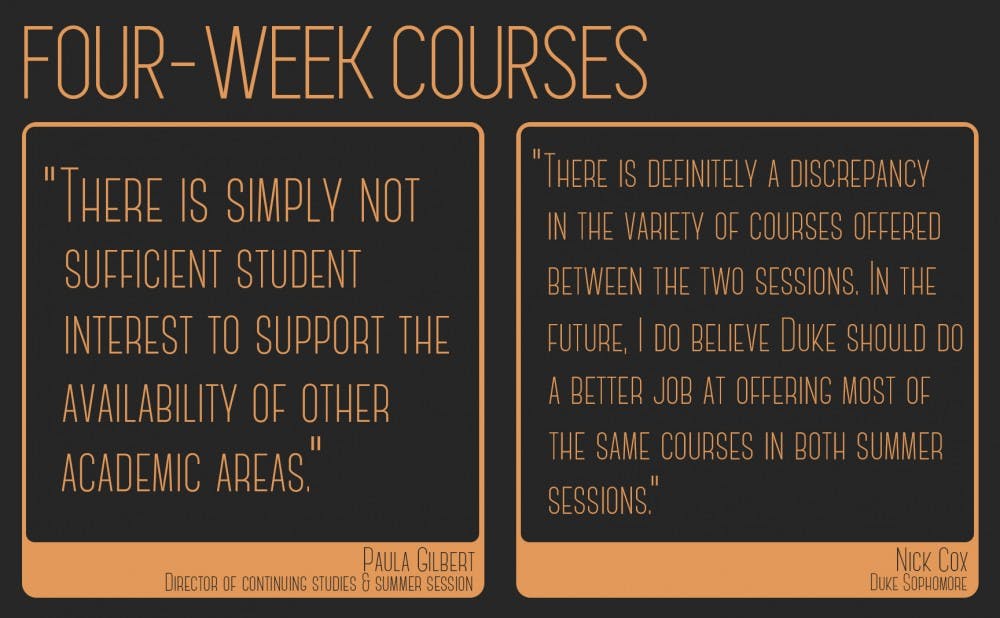Declining student interest in four-week summer classes has forced the University to offer fewer courses of that length.
Four-week summer courses were first introduced in 2013, but in recent years fewer students have enrolled in them, particularly during Session I. As a result, the number of four-week courses offered during Session I has been cut to just three, compared to the approximately 29 four-week courses available in Session II. Paula Gilbert, director of continuing education and summer session, wrote in an email that there were originally nine four-week Session 1 classes this year.
“There is simply not sufficient student interest to support the availability of lots of courses in other academic areas,” Gilbert wrote.
This summer, the three Session 1 courses included a writing class, one on research methods in psychology and a public policy course. None of the courses fulfill statistical science, civilizations, natural science, quantitative science or cross-cultural inquiry requirements.
Gilbert noted that a possible reason for the low enrollment in four-week courses is that most students either take courses that fulfill those requirements or take two classes at once—an option that is only permitted for six-week courses.
Instructors generally nominate themselves to teach a summer course and decide whether that course will be completed in four or six weeks. Courses involving lab sciences and math are usually six weeks long because many of them are core classes and require more time to teach.
“Many of these courses are ones that serve as building blocks for other classes so it is especially critical for students to have the opportunity to learn the materials in a deep and thorough fashion,” Gilbert wrote.
Sophomore Nick Cox chose to take Molecular Biology, a lab science course, to complete a major requisite. The lack of four-week courses did not affect him, but he said he would have considered taking the course in four weeks if it were offered, although it ultimately would have felt too condensed to be manageable.
Cox also noted the imbalance between the two summer sessions.
"There is definitely a discrepancy in the variety of courses offered between the two sessions," Cox wrote. "In the future, I do believe Duke should do a better job at offering most of the same courses in both summer sessions."
Session II four-week courses have not suffered the same drop in popularity as the Session I courses.
Gilbert explained that Session I courses mostly consist of regular Duke undergraduates. Session II, by contrast, includes students in the David M. Rubenstein Scholars Program, incoming freshmen student-athletes, international college students and high school students in summer college programs. Gilbert estimates that Session II enrollment partially consists of approximately 450 of these students.
“The majority of the 4-week program participants consist of students from these visiting constituencies,” she wrote. “Their presence makes it possible to offer and fill many more four-week classes in Term II.”
Gilbert said summer opportunities like DukeEngage, the Marine Lab and research positions that start toward the beginning of summer are additional reasons why fewer students are interested in Session I four-week courses and thus why fewer instructors choose to offer them.
Kelsey Lucca is not one of those professors. Rather, she views the Session I four-week courses as the ideal way for students to finish a class before beginning an internship or another summer activity. But she also understands why students may not be interested in them.
“I think one of the downsides was Session I is toward the end of the [spring] semester,” she said. “The students don’t really get a chance to get a break. I imagine a lot of faculty also want a break between the spring and the summer session.”
Another challenge for the faculty is the rigorous pace necessary to cover the material in the short four-week span. Lucca said she had to choose depth over breadth to ensure her students understood the material more thoroughly.
“It was a very intense workload,” she said. “It’s two hours a day of teaching, so that’s a lot of prep work. You get worried that students would lose engagement in the class.”
Get The Chronicle straight to your inbox
Signup for our weekly newsletter. Cancel at any time.

